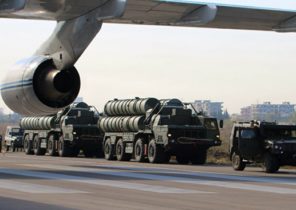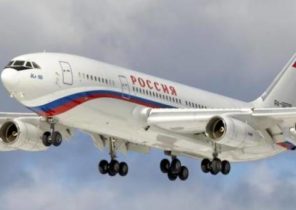After Turkey signed an agreement with Russia on a ceasefire in the Syrian province of Idlib, the tense situation in the country softened, and in the Turkish sky ceased to appear numerous combat aircraft.
Before signing the agreement all parties to the conflict, leading military action on Syrian soil and in the air, seriously complicated the Syrian issue. Many difficulties brought part of the fighter-bomber su-34 and F-16 fighter.
What is the “trump card” allowed the fighter-bomber, nicknamed the “duck” to escape to the front? Can he after 20 years of “training” to become for the Russian army air weapons of ground targets? Let’s face it.
The exact definition
“Professional attack” with flexibility and strength
In the neutralization of several local conflicts in the 80-ies of the last century improved precision guided weapons, greatly changed the style of warfare in the air. More than fast fighter-bombers, able to effectively break through to the target, began to perform more and more missions. The main combat power of the Russian air force at that time was still su-24. They were in service for over 10 years and is slightly behind in its development changed the battle space, they have begun to identify various shortcomings.
In 1986, the experimental design Bureau of P. O. Sukhoi began work on creating a new fighter-bomber, which by the mid 90-ies was to replace the su-24 when performing tasks in the attack of tactical targets located deep in the enemy’s territory. Soon, however, instead of creating a new fighter-bomber, the Sukhoi design Bureau it was decided to optimize and upgrade existing aircraft.
For the template it was decided to take advanced at the time the su-27. Due to the rapid changeover, the su-34 before they emerge has been a wonderful “base”, for the same reason, it was soon renamed the su-27IB.
In 1990, after nearly four years, the new fighter-bomber first took to the sky. But when the air breathed by the collapse of the Soviet Union, the development process of su-34 started to slow down due to fell down on his difficulties in view of the fragility of the situation and lack of funds. The beginning of the XXI century, the Sukhoi design Bureau produced only a few test models. On arms of the Russian air force su-34 entered only in 2007.
Su-34 has outstanding maneuverability swept wings, two engines and two-keel vertical tail surfaces, as adopted design solutions inherent in the su-27. In the front of the plane is a movable horizontal tail, has improved its aerodynamic performance, as well as su-27, he is able to perform aerobatics “Cobra”. And yet su-34 is considered a fighter-bomber, the su-27 distinguishes the ability to “strike at the earth from the air” and “great power”. These characteristics ensure “uniqueness” of the su-34: it basically strikes on fixed objects, representing a high value, such as military airfields, communications centers and command centers located deep in the enemy territory.
The standard bomb load of the su-34 is 8 tons, so it can be called mobile “the Arsenal of aviation weapons”. In addition to one 30-mm aircraft cannon, the fighters on Board can be placed 12 weapons, with which it carries out attacks, including missiles to destroy ground and surface targets, as well as managed and cluster bombs. In self-defense on Board the su-34 can be missile of class “air-air” near and average range. If necessary, a fighter can also be hung from aircraft, cruise missiles and nuclear bombs. Thanks to a powerful weapons system of the su-34 became a “professional enforcer”.
In order to shake its “heavy fist”, the su-34 is equipped with two turbofan engines with afterburners, with very high traction. At sea level the aircraft is capable of speeds equal to Mach 1.2. Su-34 is also different flight range: fuel from its own tanks can last 40 thousand kilometers. In the presence of external fuel tanks or refueling, the su-34 can fly the whole of Russia in just a few hours.
Exceptional capabilities to attack ground targets
“Accurate weapon”, able to RAID on a tiny object
The Sukhoi design Bureau has made every effort to improve the devastating power of the su-34 when attacking ground targets. For example, the most recognizable part of the plane — his nose, resembling a “duck beak” is a real design masterpiece. Flattened the front part is not only will there be originality to the appearance of a fighter, but also gives a lot of advantages.
Just as the beaks of these ducks are filled with nerve endings, “a duck nose” su-34 equipped with radar. The space inside the flattened front of the plane allows to place there a more efficient multi-function radar of larger diameter having the diffraction function of the relief and guaranteeing a strike at goal under specific weather conditions.
Thanks to the “duck beak” in the cabin has more space. Unlike other fighters of the same type, the chairs of the pilots in the su-34 are not located one behind the other, and in series, as in a passenger plane or a strategic bomber. It promotes effective interaction between pilots and wider viewing angle. Spacious cabin even allows pilots to get up to stretch your legs, or retire to the depth of the cabin for a little rest. To make long flights more comfortable under the seats of the pilots were installed toilets.
Increasing the level of self-defense is of particular importance for a fighter specializing in overcoming the defenses at low and very low altitude. The rugged design of the fuselage of the su-34 and system redundancy enhances the survivability of the fighter on the battlefield. The cockpit is further reinforced by an armored shell of titanium alloy. Pilots as if they were in “iron bath”, an armored partition protects pilots and equipment against fire from anti-aircraft guns, small-caliber anti-aircraft guns and shrapnel missiles. It is reported that for the observation of enemy aircraft, able to strike from behind, and accurate response in the tail boom mounted radar rearview.
Thus in recent years the Russian side has upgraded avionics, a fire control system, electronic warfare, suspended and modular reconnaissance equipment of the su-34, significantly increasing its survivability, maneuverability, and combat effectiveness.
For this reason, after its introduction of the su-34 performed well on the battlefield. The shadow of the su-34 was visible everywhere: from the Russian-Georgian conflict in 2008, to fight ISIS (a terrorist organization banned in Russia. — approx. ed) in 2015, as well as during the recent aircraft collisions on the Turkish-Syrian border. In early March in Syria with anti-radar missiles, the su-34 destroyed part of the enemy early warning radar.
Future prospects
Fighter-bomber collided with a “matter of time”
Su-34 adopted at the beginning of the XXI century, in comparison with the developed at the same time, the fourth-generation fighter, he has one congenital defect: the plane has no stealth characteristics. Since the Gulf war, the primary task for “knocking doors” rests on the shoulders of stealth aircraft. The emergence of the tactics of the “application a shot outside the defended area,” considerably reduced the ability of fighters to overcome the air defense zone at low altitudes. In this regard, many, probably the question arose, not whether the obsolete fighter-bomber in the era of increasing Informatization of military action? Will not have su-34 with the risk of being rejected?
Given the current situation, the fighter-bombers too early to send “retired”. If the air defense system of the enemy is weak, greater range and bomb load su-34 will be a welcome addition, as the aircraft is able to attack from a long strafe. This is evident in real combat achievements after the adoption of the su-34.
And still no stealth characteristics, based on one’s ability to overcome air defenses at very low altitude, does not go far. Tactics to overcome the air defense zone at a very low altitude still has practical combat value, however, the rapid development and improvement of radar and air defense systems, will inevitably reduce its combat effectiveness. Currently, some countries have already equipped their aircraft early warning radar modern radars with phased array, which allowed them to effectively filter or suppress the response interference coming from the sea or land, and to find the aircraft, using the difficulties of the terrain for penetration at extremely low altitudes. In addition, the implementation of search and persecution with the help of radar and electro-optical equipment, increase in power system protection at low altitudes, the adoption and use of man-portable anti-aircraft missile and missile-gun complexes as well as the development of anti-aircraft weapons directional, reducing the capacity of fighters, specializing in overcoming air defense under the radar and even threatens their existence.
Currently, weapons and military equipment are becoming more and more “professional” and “universal”. In future wars the task of bombing will carry out a manned or unmanned bombers with improved stealth characteristics, and with the task to attack ground and sea targets will handle the medium and heavy multi-role fighters. All this complicates the future of “niche” su-34.
Of course, despite the changes in forms of war, the use of any weapons or tactics. To create a complete structure of the fighting on their good side will flaunt and the negative to escape. Su-34 will be able to play the role of “air truck bombs” and other weapons and military technology to find its own unique purpose.







